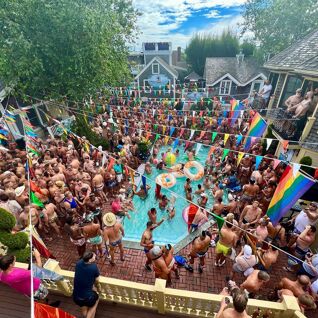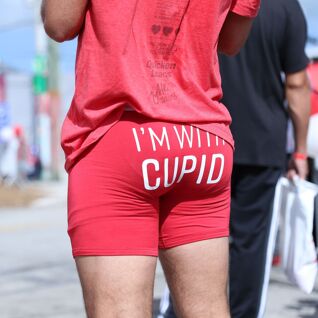 All right, calm down everyone. Mainstream media has latched on to the theory that our ‘hoods are vanishing, and soon we’ll be left with, well, Topeka. No more Castro, no more Village, no more Boystown, no more P-town. It’s a scary thought. And it would be quite a loss not just for us but for the rest of the world as well.
All right, calm down everyone. Mainstream media has latched on to the theory that our ‘hoods are vanishing, and soon we’ll be left with, well, Topeka. No more Castro, no more Village, no more Boystown, no more P-town. It’s a scary thought. And it would be quite a loss not just for us but for the rest of the world as well.
And while it’s undeniably true that gay ghettos are undergoing rapid transformations, there’s no need to get hysterical. They’re changing, not dying. In some ways, they are in fact changing for the better, and that they’ll be around for a lot longer if they we keep improving the institutions we love that find their homes in the urban areas we love.
If you don’t believe us, just check out Sunday’s Castro Street Fair. Yes, there will be non-gay people there, some of whom moved to the ‘hood to claim their part in the great life we have created. And lots of visitors, too. But it will be run by local merchants and feature tens of thousands of local LGBTers. Today the Castro thrives as never before.
Here are five reasons why we’re confident the gayborhood is here to stay:
Sex
If you want to get right to the meat of it (and we do), queers will always need a place to flock together if for no other reason than to satisfy their libidos and find a mate (or mates). Decades ago, that might’ve been a public bathroom. More recently, it’s been bars. And no matter social networks and smart phones, at the end of the day you’ll always need to close the deal with, you know, actual pants down experience.
We’ll always need gay bars in our gay ghettos. And we’ll need some sex shops, too — you might be able to subscribe to Boy Butter on Amazon, but there’s no substitute for an expert harness fitting at Rough Trade.
Of course, having more straight people at gay bars throws a wrench in your hookup plans. You might order a drink and try to chat up a handsome stranger, only to find out that he’s there with his wife. And, yes, it’s annoying when a screeching group of heterosexual bachelorettes descends on The Abbey.
But somehow, we are confident that gay sex will endure the presence of a few breeders. In fact, our new straight neighbors might actually help keep our favorite gay bars in business. After all, times are tough for homosexual watering holes. Business has been drying up thanks to the rise of sex-locating apps.
Culture
Drag queens aren’t going anywhere. Seriously, just try to get ’em to leave a place. They won’t budge.
Just look at San Francisco’s SoMa: it used to be the city’s gay ghetto up until the ’80s. And even though it’s become more homogenized, it still boats leather shops, sexy street fairs and clubs like The End Up and The Eagle. Trannyshack’s always been at home in SoMa, thriving throughout a move from The Stud to DNA Lounge and to a new location before year’s end.
Tourism
Once upon a time, cities neglected their gay ghettos. Now they are embraced and showered with amenities, such as the wider sidewalks and trees that line Santa Monica Boulevard in West Hollywood and the rainbow crosswalks and historical markers in the ‘Stro.
Those amenities aren’t just for the benefit of residents. They’re also there to bring in visiter’s dollars. When gays go traveling, we’re apt to seek out the gayborhoods for a good time. So even if the locals are bored with the same old bar, visitors are only too happy to explore.
And of course, Pride draws monumental crowds. Even if it’s just once a year, Pride celebrations require an epicenter.
Social Services
This might not be the sexiest reason for a gayborhood to exist, but the social services offered by queer-focussed nonprofits can literally be life saving.
At some point, you’ve probably been to a clinic to be tested, counseled or treated. You may have gone to the local AA meeting held at the MCC church. Perhaps you’ve been to a job fair at the community center. Maybe you signed up for the softball team your favorite watering hole sponsors. Or hooked up with Frontrunners for an early morning jog. If you live near a gay ghetto, there’s a good chance you’ve taken advantage of these opportunities and services.
Many orgs offer youth-oriented services, which is particularly vital for kids who are kicked out of their homes and head to the ‘hood looking for help and a home. Homeless queer kids often find themselves drawn to gayborhoods, since they’re often the safest place for them.
Just as with cultural institutions, gays may drift away from a geographic location, if only because of high real estate prices, but they’ll always come back for social services and social outlets when needed.
New Communities
You know what? Cities change. Neighborhoods evolve. Demographics shift. Even hairstyles can’t stay the same.
Even if a particular gayborhood withers, scattering its queers to the wind, they’ll all take root somewhere else. Just look at what’s happening in the Bay Area right now: the city of San Francisco is losing modestly priced dwellings to the whitewashed lofts of millionaires, and since gay households tend to make less than straight households, it may well be that we are disproportionately affected. But this doesn’t spell the end of gayborhoods — they’re just resettling across the bay, in Oakland or Richmond.
The East Bay has always enjoyed a large LGBT population, and over the next few years, that population is likely to coalesce around a geographical point. Just like how the gayborhoods moved and spread from Polk Street to SoMa to the Tenderloin and to the Castro over the last century. Or how it moved from Hollywood to WeHo.
Don't forget to share:


















